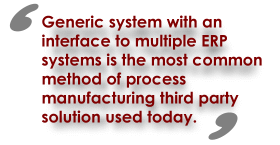
Automation, Control & Plant Intelligence - Articles, Analysis, Reviews, Interviews & Views

 According to Evan Garber, President of Escape Velocity Systems (www.evs-sw.com) there are three methodologies used by third party developers of process manufacturing software:
According to Evan Garber, President of Escape Velocity Systems (www.evs-sw.com) there are three methodologies used by third party developers of process manufacturing software:
YOU MAY LIKE:
Popular Articles
Manufacturing Insights